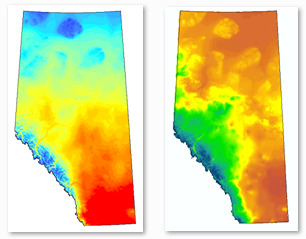 The software, downloadable from this web page, can be used to estimate more than 50 monthly, seasonal, and annual variables, including many economically or biologically relevant variables such as growing and chilling degree days, heating and cooling degree days, drought indices, beginning and end of the frost-free period, etc.
The software, downloadable from this web page, can be used to estimate more than 50 monthly, seasonal, and annual variables, including many economically or biologically relevant variables such as growing and chilling degree days, heating and cooling degree days, drought indices, beginning and end of the frost-free period, etc.
Unlike our North America-wide software packages, the model for the 1961-1990 normal reference period is based on the Alberta Climate Model, implemented with an ANUSpline interpolation of a very large number of weather stations that are not publicly accessible. The model has been proven accurate for this region, and we therefore recommend it for research that focuses on Alberta.
Historical data covers 1901-2020 are based on the CRU-TS 4.05 dataset (Harris et al, 2020, Scientific data 7: 109). Future projections are based on 15 AOGCMs of the CMIP5 multimodel dataset corresponding to the IPCC Assessment Report 5 (2013) x 2 Emission Scenarios (RCP4.5 and RCP8.5) x 3 standard time-slices (2020s, 2050s, 2080s). Average projected global warming increase (and likely range) for RCP4.5 are: +1.4°C (±0.5) by the 2050s; +1.8°C (±0.7) by the 2080s. For RCP8.5 they are: +2.0°C (±0.6) by the 2050s; +3.7°C (±0.9) by the 2080s.
The 15 AOGCMs are CanESM2, ACCESS1.0, IPSL-CM5A-MR, MIROC5, MPI-ESM-LR, CCSM4, HadGEM2-ES, CNRM-CM5, CSIRO Mk 3.6, GFDL-CM3, INM-CM4, MRI-CGCM3, MIROC-ESM, CESM1-CAM5, GISS-E2R and were chosen to represent all major clusters of similar AOGCMs by Knutti et al (2013). Within clusters, we selected models that had the highest validation statistics in their CMIP3 equivalents.
Download Links
This program does not require installation. Download, unzip, and double click the executable file ClimateAB.exe. The program should run on all versions of Windows. If you receive the error message "COMCTL32.OCX missing", you have to install these libraryfiles. The program also runs on Linux, Unix and Mac systems with the free software Wine or MacPorts/Wine).
References
For usage, cite "Climate data has been generated with the ClimateAB v3.21 softwarepackage, available at http://tinyurl.com/ClimateAB, based on methodology described by Mbogga et al. (2010) and Alberta Enviroment (2005)."

